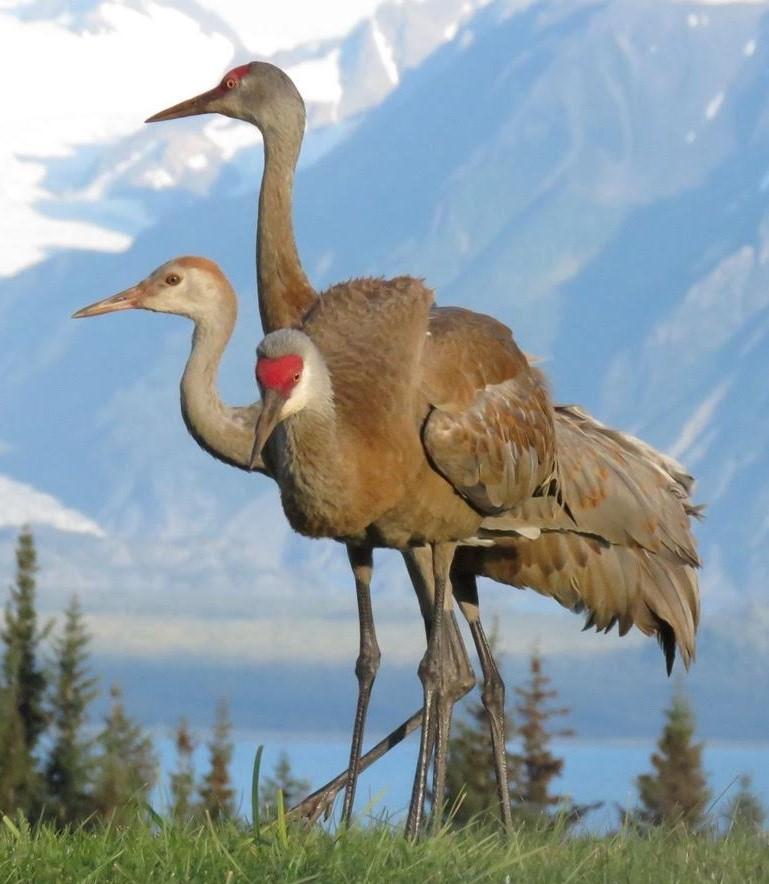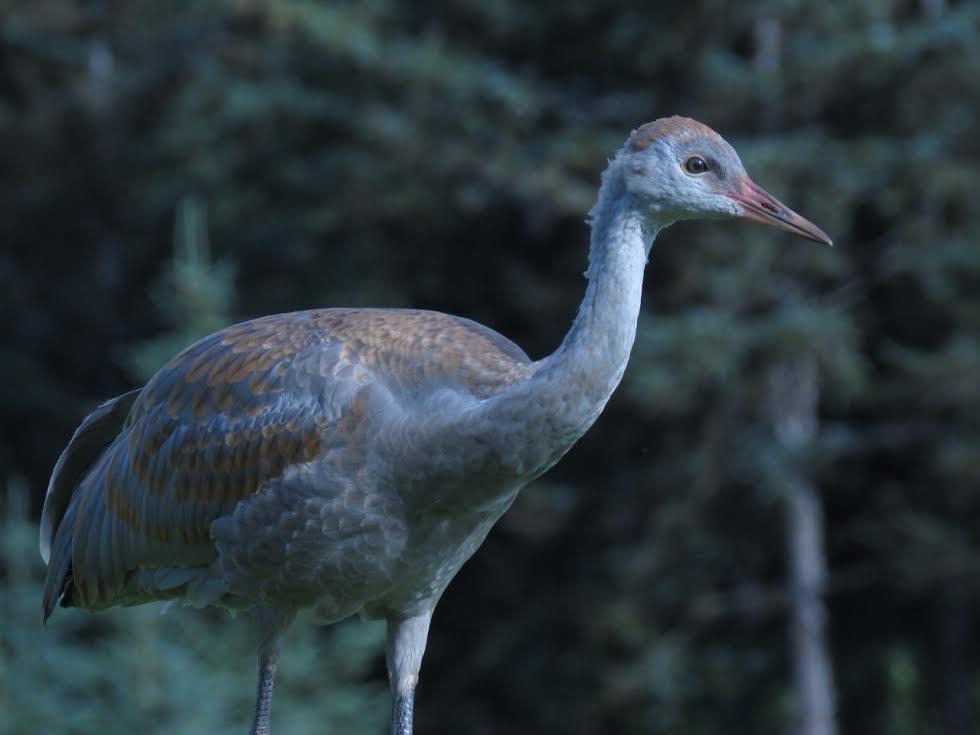Every spring, hundreds of sandhill cranes visit Homer to mate and nest. You’ll often find them looking for tasty morsels along the shoreline or silently strutting across your backyard. For the last thirteen years, Kachemak Crane Watch has organized a “sandhill crane count” to keep track of their population.
A sandhill crane looks and sounds like a modern day dinosaur.

(Photo courtesy of Nina Faust)
They stand about three feet tall and have a six-foot wing span. They use their sharp four-inch beak for probing in the dirt and catching insects and small mammals.
And sometimes, they use that long beak for defense.
“That beak is a very very lethal weapon,” says Faust.
That’s Nina Faust. She’s the co-founder of Kachemak Crane Watch, a non-profit organization dedicated to the conservation of sandhill cranes.
“I think they’re very majestic birds. A lot of people describe them as regal, they move like royalty and they’re just very elegant. When they dance, it’s just the most gorgeous thing you’ve ever seen,” says Faust.
A flock of 20 lesser sandhill cranes forages in a grassy field at Inspiration Ridge Preserve in Homer. Faust points to a group of three cranes standing close together.
“You can see a family right there. The adults have red on the top and they have a yellow eye. The young are totally golden colored with no red top and a dark eye,” Faust explains.
They’re getting ready to migrate 2400 miles to their overwintering grounds in Sacramento, California. But before the cranes leave in mid-September, Faust has a job to do.
Every fall, she organizes a “citizen science” survey of the crane population on the southern Kenai Peninsula. On three specific days, residents contact her to report sandhill crane sightings. Using this information, she’s able to estimate how big the population is each year.
Habitat loss and predation can have a big effect on the crane population, says Faust. Around Kachemak Bay, bald eagles are a constant threat.
“It’s interesting to watch because sometimes they’ll see the eagle way off in the distance and they’ll start giving this little brrr growling call. Everybody stands up and looks and they all get ready. If it gets closer, poof, they’re gone!” Faust laughs.

(Photo courtesy of Nina Faust)
A large-scale die-off of Common Murre seabirds in early summer attracted bald eagles to the Homer area. Faust says that many of the eagles appear to have stayed behind and are now preying on other animals, including cranes.
Another potential hazard? Humans.
“You almost never see them on roads. But this year, there’s been a problem because someone who lives on a busy road started feeding them. And they’ve been starting to walk all over the neighborhood. I’ve had people stopping me in the post office, calling me on the phone, saying what’s with the cranes marching down the middle of the road in Homer?” says Faust.
Cranes strolling in downtown areas risk getting hit by cars. They can also fly into power lines.
“I mean, my gosh. They get panicked and they can fly right into ‘em. It breaks their wings, it can rip their beaks off. Just a horrible death,” says Faust.
Despite these threats, this year’s survey showed that the lesser sandhill crane population in Homer is holding steady at about 200 individuals. The population produced 47 babies this year, but only 30 survived to the end of the nesting season. That’s about normal.
In early September, the sandhill cranes left Homer and headed back to California’s Central Valley.
Faust and her fellow “craniacs” watched the last cranes depart for the year. She says this time always feels bittersweet.
“It leaves a big hole in your heart,” she says.
In California, Bart McDermott is eagerly awaiting the arrival of the cranes. He manages Stone Lakes National Wildlife Refuge, just south of Sacramento. He says the cranes start arriving in early October.
“You start to hear them first. If you’re fortunate enough, you can hear their prehistoric sounding cackle,” McDermott says.
The cranes roost in wetlands at night and go out into neighboring agricultural fields during the day to forage for grain. But McDermott says that the cranes are facing a growing list of threats in the Sacramento area.
“Unfortunately there’s a lot of urban development. So we’ve seen a lot of these fields that cranes typically go out and forage in start to be converted into housing developments ,” he says.
The ongoing drought in California also poses a risk to cranes.
“In order to have a wetland you need water. And you need a lot of water. The birds also rely on the farmers having water to grow those crops. There’s also concerns of wildlife diseases. You get smaller areas where you have higher concentrations of birds roosting in water and there’s the risk of disease communication and outbreaks,” says McDermott.
The cranes will remain in California through the winter, before heading north in late February. For now, craniacs in Homer will have to wait until spring before these graceful giants return to nest.
Shahla Farzan is a reporter with KBBI - Homer.
Shahla first caught the radio bug as a world music host for WMHC, the oldest college radio station operated exclusively by women. Before coming to KBBI, she worked at Capital Public Radio in Sacramento and as a science writer for the California Environmental Legacy Project. She is currently completing her Ph.D in ecology at the University of California-Davis, where she studies native bees.
When she's not producing audio stories, you can find Shahla beachcombing or buried in a good book.




